
When Native Plants Go Feral
Cynthia Jarratt
Note: This article originally appeared in 'Brigge', the newsletter of the friends of Burrendong Arboretum. The Arboretum is located in the central west of New South Wales, near Wellington.
Visit the Burrendong Arboretum website
From 'rare and endangered' to 'countless and invincible', there are many Australian plants that, when planted out of their natural area, simply go feral! Basically these plants become a weed - a plant growing where it is not wanted often having an economic (agriculture) or environmental impact.
So what makes plants, and particularly native plants, weeds? Essentially they are able to adapt to their new environment, multiply and invade surrounding areas and compete for moisture, soil nutrients and space - they can take over an entire area and choke out other local plant species. Biologically they may carry or be more prone to disease and pest attack which in turn could effect local species.
| |
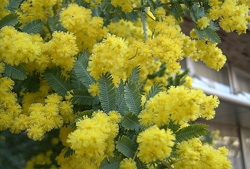 |
| |
Acacia baileyana
Photo: See footnote |
A CSIRO report for WWF-Australia by Groves, Boden and Lonsdale (February 2005) titled 'Jumping the Garden Fence - Invasive garden plants in Australia and their environmental and agricultural impacts' says that "Weed competition is the primary cause for the extinction of at least 4 native plant species, and another 57 are currently threatened or will become so through competition of weeds. The impact of weed competition is increasing as a major threat to the survival of many native plant species." The report is an interesting read highlighting a number of native but mostly exotic plants that have become feral.
Contributing to the situation is when people throw an apple core or peach seed out the window because it will degrade. However on a true conservation level this is the worst form of disposal. How many apple or stonefruit trees have you seen along our highways? Aside from being 'out of place' fruit trees are highly prone to fungus diseases and pest attack which could in turn effect native species in the area.
Perhaps one of the most widely known native plants to go feral and become a weed is the Cootamundra Wattle, Acacia baileyana. This beautiful fast growing acacia with its grey-green foliage and golden flowers is naturally restricted to the South Western Slopes of New South Wales. However when planted in higher rainfall areas it has been known to aggressively invade surrounding bushland, self seed and become a general nuisance. Unfortunately because of its beauty and ability to grow quickly this species is still widely cultivated and used in gardens as screens and hedges.
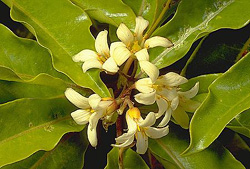 |
|
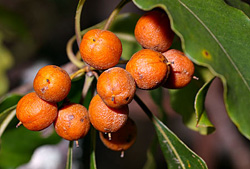 |
|
Flowers and fruit of
Pittosporum undulatum
Photos: Brian Walters |
|
Sweet pittosporum (Pittosporum undulatum) is another example of a native species gone feral; a tall shrub or small tree native to wet forests in coastal areas between the Great Dividing Range and the sea from southern Victoria to southern Queensland. It is noted for its creamy white, sweetly-scented flowers and brightly coloured clusters of orange fleshy fruit- that just happen to be attractive to birds!
Sweet pittosporum is now a serious weed problem outside its natural range in Victoria, South Australia, Tasmania and Western Australia. It is present on King, Lord Howe and Norfolk islands and many countries overseas including Jamaica, the Azores and South Africa. It is already a serious weed in the Sydney area and NSW mid-north coast.
Spread of sweet pittosporum has been encouraged by horticultural advocates extolling its hardiness and sweet perfume and by a range of fruit eating native and exotic birds.
Sweet pittosporum impacts on natural environments through shading, competition and changes in soil nutrients. By invading native bushland it has removed fire-adapted species and changed fuel loads, even though it is fire-sensitive.
I bet you're hoping you don't have this in your garden!
And I can hear you asking, 'Well if it's cultivated and sold at a nursery how are we to know that it can be become invasive?'
This is a fair and reasonable question and unfortunately I don't have the answer; perhaps someone else can shed some light on the matter? I know I found out when I tried to introduce a lovely blue tussock, Poa labillardieri, to our cottage garden on my in-laws' farm. As the 'new' daughter-in-law, keen to please and show my gardening prowess, I was promptly told that poas have a tendency to become feral and that I shouldn't plant them! With six little plants in tow I went back to the nursery to explain the situation and ask for a refund. Of course they didn't believe they were a potential threat because they only purchase stock from reputable suppliers! They did however take them back and refund my money.
| |
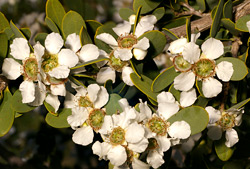 |
| |
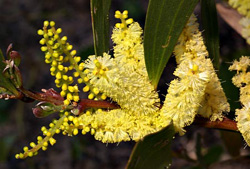 |
| |
Top: Leptospermum laevigatum
Bottom Acacia longifolia
Photos: Brian Walters |
Our gardens unfortunately are usually the beginning of many ferals; mostly exotic ornamental species that adapt and flourish in the Australian environment - lantana, Patterson's curse, sweet briar, freesias and blue heliotrope to name a few. The latter in particular appears to run rampant in the Wellington shire including the Arboretum - it is a notoriously difficult weed to control with a long tap root that, if broken, can easily re-shoot.
Listed below are the ten most serious invasive garden plants still available for sale in southern Western Australia, how many Australian or native species can you spot?
- Arum lily; Zantedeschia aethiopica
- Black flag; Ferraria crispa
- Broadleaf pepper tree; Schinus terebinthifolius
- Coastal tea tree; Leptospermum laevigatum
- Freesia; Freesia alba x leichtlinii
- Spotted gum; Corymbia maculata (syn. Eucalyptus maculata)
- Sweet pittosporum; Pittosporum undulatum
- Sydney golden wattle; Acacia longifolia
- Watsonia; Watsonia spp.
- Weeping white broom; Retama raetum (not yet widespread weed)
Again the CSIRO report explains "In the 1970s widespread planting of Australian native species in public and private gardens took place and often with little understanding of how native plants would perform in horticulture. If the plant occurred naturally somewhere in Australia it qualified for the term 'native' and was proudly grown. Some species failed while others were so successful they sometimes 'jumped' the garden fence and became naturalised in the bush. At that time it would have been un-Australian to call these species 'weeds'.
Where there is an emphasis on native plants in public plantings currently it is usually on 'locally native', i.e. species that occur or previously occurred naturally in the area where it is to be planted. Some councils even require that plants be raised from seed or cuttings collected within their local region."
Sources
Australian Weeds Committee. National Weeds Strategy website (Sweet pittosporum information)
CSIRO Report for WWF
From 'Brigge', the newsletter of the Friends of Burrendong Arboretum Inc., January 2008.
* Acacia baileyana reproduced under the GNU Free Documentation License from Wikimedia Commons.
Australian Plants online - 2008
Association of Societies for Growing Australian Plants
|